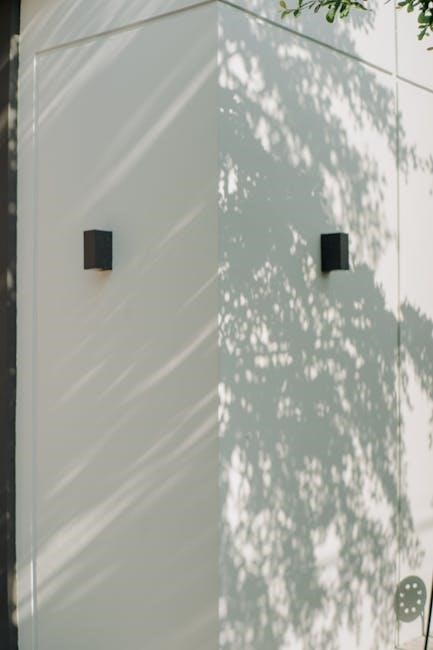
angles worksheet pdf
Angles are fundamental in geometry, formed by two rays sharing a common endpoint. Understanding angles is crucial for solving problems in construction, art, and engineering. Free printable worksheets offer comprehensive practice, covering angle classification, measurement, and real-world applications, making them essential tools for students and educators alike.
1.1 Basic Definitions
An angle is a geometric figure formed by two rays sharing a common endpoint, known as the vertex. The measure of an angle is expressed in degrees, ranging from 0° to 180°, and can be described as acute (less than 90°), right (90°), obtuse (between 90° and 180°), or straight (180°). Understanding these basic definitions is essential for solving problems involving angles in various geometric contexts. Free printable PDF worksheets provide exercises to identify, classify, and measure angles, helping learners grasp foundational concepts. These resources are ideal for students and educators seeking to build a strong understanding of geometry basics.
1.2 Importance in Geometry
Angles are a cornerstone of geometry, essential for analyzing shapes and structures. They are used to define properties of lines, triangles, and polygons, influencing calculations in areas like construction, engineering, and art. Understanding angles is critical for solving problems involving measurement, classification, and spatial relationships. Free printable worksheets provide exercises to explore these concepts, reinforcing foundational skills. These resources are invaluable for students and educators, offering practical tools to master geometry fundamentals. By practicing with these materials, learners can confidently apply their knowledge to real-world challenges.
Types of Angles
Angles are categorized into acute (0°-90°), obtuse (90°-180°), right (90°), and straight (180°). These classifications are essential for solving geometry problems and understanding spatial relationships.
2.1 Acute, Obtuse, Right, Straight
An acute angle measures less than 90°, while an obtuse angle is greater than 90° but less than 180°. A right angle is exactly 90°, often denoted by a square, and a straight angle measures 180°, forming a straight line. These classifications are fundamental in geometry for solving problems and understanding spatial relationships. Worksheets often include exercises to identify and classify these angles, helping students grasp their properties. For example, in a triangle, knowing the types of angles can determine if it’s acute, right, or obtuse. This knowledge is also applied in real-world scenarios like construction and art. Regular practice with worksheets ensures mastery of angle classification.
Classifying Angles
Angles are classified by their measures into acute (less than 90°), obtuse (more than 90° but less than 180°), right (exactly 90°), and straight (180°). Free printable PDF worksheets provide exercises to master angle classification.
3.1 By Measure
Angles can be classified by their degree measures into four main categories: acute (less than 90°), obtuse (more than 90° but less than 180°), right (exactly 90°), and straight (180°). This classification is fundamental in geometry and is widely used in various mathematical problems. Free printable PDF worksheets often include exercises to identify and measure angles, helping students master this concept. Understanding angle measures is essential for solving problems involving triangles, quadrilaterals, and other polygons. These worksheets provide clear examples and practice questions, making it easier for learners to grasp the differences between angle types and apply them in real-world scenarios. Accurate classification by measure is a cornerstone of geometric analysis.
3.2 By Direction
Angles can also be classified based on their direction in space. This classification is essential for understanding relationships between lines and angles, especially in problems involving parallel lines and transversals. Terms like clockwise and counterclockwise describe the direction in which angles are measured. Angles can also be described as orientated in specific ways, such as upward, downward, or sideways, depending on their position. Free printable worksheets often include exercises to identify and label angles based on their directional properties. This skill is crucial for solving problems in geometry, particularly those involving corresponding angles, alternate interior angles, and more complex spatial relationships. Understanding directional angles enhances problem-solving abilities in various mathematical contexts.

Naming Angles
Angles are commonly named using three letters, with the vertex in the middle. This method ensures clear identification and is essential for solving problems in geometry.
4.1 Using Points and Rays
Angles are named using three points: one for the vertex and two for the rays. This method ensures clarity in geometry problems. The vertex is the central point, and the rays are the sides extending from it. By labeling angles with points and rays, students can easily identify and reference them. Free printable worksheets often include exercises to practice this naming convention, reinforcing understanding. Proper notation is essential for precise communication in geometry, making it a foundational skill. This approach helps in solving complex problems and ensures consistency across mathematical applications. Worksheets provide ample practice opportunities to master angle naming using points and rays effectively.

Angle Addition Postulate
The Angle Addition Postulate states that the measure of an angle formed by two adjacent angles is the sum of their measures. This postulate is vital in geometry for solving problems involving angle sums. Worksheets provide exercises to apply this postulate, enhancing problem-solving skills. By breaking down complex angles into smaller, manageable parts, students can find unknown measures with ease. This fundamental concept is widely used in various geometric proofs and theorems, making it essential for a strong foundation in geometry. Regular practice with worksheets ensures mastery of this principle, preparing students for advanced geometric concepts and real-world applications.

Complementary and Supplementary Angles
Complementary angles are two angles whose measures add up to 90 degrees, while supplementary angles sum to 180 degrees. These concepts are crucial in geometry for solving problems and understanding angle relationships. Complementary angles are often used in constructing right angles, while supplementary angles help form straight lines. Worksheets provide exercises to identify and calculate these angles, enhancing problem-solving skills. For example, if one angle is 30 degrees, its complement is 60 degrees, and its supplement is 150 degrees. Regular practice with these exercises reinforces the importance of these angle relationships in various geometric principles and theorems, ensuring a solid foundation in geometry.

Angle Pair Relationships
- Angle pair relationships include vertical angles and linear pairs.
- Vertical angles are opposite and equal, while linear pairs are supplementary.
- Worksheets provide exercises to identify and calculate these pairs, enhancing geometric understanding.
7;1 Vertical Angles
Vertical angles are formed when two lines intersect, creating pairs of opposite angles. These angles are equal in measure, as demonstrated in various free geometry worksheets. Students can practice identifying and calculating vertical angles using printable PDF resources, which often include diagrams and exercises. For instance, if one vertical angle measures 45 degrees, its opposite will also measure 45 degrees. This concept is crucial for understanding more complex geometric principles. Worksheets provide step-by-step guides and real-world applications to reinforce learning. By mastering vertical angles, students build a strong foundation for advanced geometry topics.
7.2 Linear Pairs
A linear pair consists of two adjacent angles forming a straight line, totaling 180 degrees. These angles are supplementary and share a common side. Worksheets often include exercises where students identify and calculate the measures of linear pairs. For example, if one angle in a linear pair measures 60 degrees, the other must measure 120 degrees. Practice problems in PDF format provide clear diagrams and step-by-step solutions, helping students grasp this concept. Understanding linear pairs is essential for solving real-world geometry problems, such as calculating distances or designing structures. These exercises build foundational skills for more complex geometric principles.

Geometry Diagrams
Geometry diagrams visually represent points, lines, angles, and shapes. Free PDF worksheets include labeled diagrams to help students understand and solve problems, enhancing their spatial reasoning and problem-solving skills.
8.1 Labeling Angles
Labeling angles accurately is essential for clear communication in geometry. Points are named with capital letters, and angles are identified using these points. For example, angle ABC is labeled with vertex B. Free PDF worksheets provide exercises where students practice labeling angles using points and rays. Diagrams often include multiple angles, requiring precise notation to avoid confusion. Proper labeling helps in solving problems involving angle measures, supplementary angles, and complementary angles. Worksheets also include activities where students match labels to corresponding angles, reinforcing their understanding. This skill is fundamental for advanced geometry concepts, such as triangle properties and parallel lines. Clear labeling ensures accuracy in calculations and visual representations.
8.2 Measuring Angles
Measuring angles accurately is a foundational skill in geometry. A protractor is the primary tool used to determine the degree of an angle. Free PDF worksheets include exercises where students practice measuring angles using protractors, ensuring precision and understanding of basic concepts. These activities cover acute, obtuse, and right angles, reinforcing the ability to identify and measure angles correctly. Worksheets often feature diagrams with angles of varying degrees, allowing students to apply their skills in different contexts; Measuring angles is crucial for solving problems involving angle sums, supplementary angles, and complementary angles. Regular practice with these exercises enhances spatial awareness and problem-solving abilities in geometry.

Solving Angle Problems
Solving angle problems involves using geometric principles and theorems. Free angle worksheets PDF provide exercises to enhance critical thinking and analytical skills in geometry.
9.1 Step-by-Step Guide
Start by identifying given angles and required unknowns. Use theorems like the Angle Addition Postulate or properties of supplementary angles to find missing values. Calculate unknown angles using these principles. Verify solutions by ensuring the sum of angles in triangles or quadrilaterals matches known values. Use free PDF worksheets to practice these steps, reinforcing understanding and problem-solving skills. This structured approach aids in mastering angle problems efficiently.
Angles in Triangles
In a triangle, the sum of all interior angles is 180 degrees. Isosceles triangles have two equal angles, while scalene triangles have all angles different. Understanding these properties is essential for solving geometric problems and can be practiced using free printable angle worksheets.
10.1 Triangle Angle Sum
The sum of the interior angles in any triangle is always 180 degrees, a fundamental property in geometry. This applies to all types of triangles, whether they are scalene, isosceles, or right-angled. Understanding this rule is crucial for solving problems involving triangle angle relationships. Free printable worksheets provide numerous exercises to practice calculating missing angles, ensuring mastery of this essential concept. By using these resources, students can explore various triangle configurations and solidify their grasp of angle properties. This foundational knowledge is vital for advancing in geometric problem-solving and real-world applications.
10.2 Isosceles Triangle Angles
In an isosceles triangle, two sides are equal, and the base angles opposite these sides are also equal. The third angle, known as the vertex angle, is different. The sum of all angles in any triangle is 180 degrees. This property allows calculation of missing angles in isosceles triangles, making them a key concept in geometry. Free printable worksheets offer exercises to practice identifying and calculating angles in isosceles triangles, enhancing problem-solving skills. These resources are invaluable for students to master angle relationships and apply them to various geometric problems and real-world scenarios, ensuring a strong foundation in triangle properties.
Angles in Quadrilaterals
In quadrilaterals, the sum of interior angles is always 360 degrees. This property helps in calculating missing angles, especially in squares, rectangles, and trapezoids. Free printable worksheets provide exercises to practice these calculations, reinforcing understanding of angle relationships in various quadrilateral types.
11.1 Sum of Interior Angles
The sum of interior angles in any quadrilateral is consistently 360 degrees, regardless of its type. This fundamental property is derived from the fact that a quadrilateral can be divided into three triangles, each having an interior angle sum of 180 degrees. Free printable worksheets offer numerous exercises where students can apply this principle to calculate unknown angles in various quadrilaterals, such as squares, rectangles, trapezoids, and parallelograms. These resources are invaluable for reinforcing the concept and ensuring mastery in geometric calculations, making them a popular choice among educators and students alike for effective practice and review.
11.2 Properties of Each Type
Different quadrilaterals exhibit unique angle properties. Rectangles have four right angles, while squares combine right angles with equal sides. Parallelograms feature consecutive angles that are supplementary. Trapezoids have at least one pair of parallel sides, affecting their angle relationships. Free printable worksheets provide detailed exercises to explore these properties, enhancing understanding and application of geometric principles. These resources are designed to help students identify and calculate angles in various quadrilaterals, ensuring a solid grasp of their distinct characteristics through practical, hands-on problems and visual examples.
Polygons and Angles
Polygons are shapes with multiple sides and angles. Regular polygons have equal angles and sides, while irregular polygons vary. Free printable worksheets explore polygon angle properties, helping students understand how angles relate to shape classification and symmetry.
12.1 Regular vs. Irregular
Regular polygons have all sides and angles equal, such as squares and equilateral triangles, ensuring uniformity in shape and structure. Irregular polygons, like scalene triangles, have varying sides and angles, offering diverse geometric properties. Free printable worksheets provide exercises to distinguish and calculate their angles, enhancing spatial reasoning and problem-solving skills. These resources are ideal for students to explore symmetry, tessellation, and real-world applications, making geometry engaging and accessible for learners of all levels.

Transversals and Parallel Lines
Transversals intersecting parallel lines create corresponding and alternate interior angles. These angles are equal, forming the basis of geometric theorems. Free geometry worksheets provide exercises to explore these properties.
13.1 Corresponding Angles
Corresponding angles are angles in similar positions relative to two intersecting lines. When a transversal cuts parallel lines, these angles are equal in measure. Worksheets often include identifying and proving corresponding angles to establish parallelism, enhancing geometric reasoning and problem-solving skills. They are foundational for understanding more complex theorems involving lines and angles, making them a key focus in geometry education. Practice with free printable PDFs helps students master this concept efficiently. Corresponding angles are essential in various real-world applications, including architecture and engineering, where precise calculations are necessary. Regular practice ensures a solid grasp of this fundamental geometric principle.
13.2 Alternate Interior Angles
Alternate interior angles are angles located inside two parallel lines cut by a transversal, on opposite sides of the transversal. These angles are equal in measure when the lines are parallel. Worksheets often feature exercises identifying and proving alternate interior angles, which are vital for understanding geometric proofs and theorems. They are particularly useful in solving problems involving parallel lines and transversals, enhancing spatial reasoning and logical thinking. Free printable PDFs provide ample practice opportunities, ensuring mastery of this key concept. Alternate interior angles are fundamental in geometry, aiding in the analysis of shapes, patterns, and structures, and are essential for advanced mathematical studies.
Circles and Angles
Circles and angles are deeply connected in geometry, with concepts like central angles and inscribed angles forming the basis of circle theorems. Worksheets provide exercises on calculating arc lengths, understanding chord properties, and solving problems involving tangents and secants. Central angles, which are angles with their vertex at the circle’s center, are essential for determining arc measures. Inscribed angles, subtended by arcs, are half the measure of their intercepted arcs. These concepts are crucial for advanced geometry, and free printable resources offer comprehensive practice, helping students master circle-related angle problems efficiently.
14.1 Central and Inscribed Angles
A central angle is formed by two radii of a circle, with its vertex at the center, while an inscribed angle is formed by two chords sharing a common endpoint on the circumference. The measure of a central angle is equal to the measure of its intercepted arc, whereas an inscribed angle is half the measure of its intercepted arc. This relationship is fundamental in circle theorems and is widely used in geometry problems. Free printable worksheets offer exercises on identifying, calculating, and applying central and inscribed angles in various scenarios, making them invaluable for students mastering circle properties and angle relationships.

3D Geometry and Angles
Explore the properties of angles in three-dimensional space, including dihedral angles between planes and the role of lines in forming complex geometric shapes. Free printable worksheets provide hands-on practice with 3D geometry problems, enhancing spatial reasoning and understanding of angular relationships in real-world applications.
15.1 Dihedral Angles
Dihedral angles measure the space between two intersecting planes in 3D geometry. They are crucial in understanding the structure of polyhedrons and molecular geometry. Free printable worksheets offer exercises to calculate and visualize dihedral angles, aiding students in grasping complex spatial relationships. These resources are essential for developing a strong foundation in advanced geometry and its applications in fields like engineering and architecture. By practicing with these worksheets, learners can improve their ability to analyze and solve problems involving dihedral angles efficiently.
15.2 Planes and Lines
In 3D geometry, planes and lines form the foundation for understanding spatial relationships. A plane is a flat, two-dimensional surface extending infinitely, while a line is a one-dimensional figure with no thickness. The interaction between planes and lines defines angles in three-dimensional space. Key concepts include parallel lines, intersecting planes, and the angles formed when lines intersect or lie within planes. These principles are essential in fields like engineering, physics, and architecture. Free printable worksheets provide exercises to visualize and compute these relationships, helping students master the fundamentals of 3D geometry and apply them to real-world problems effectively.

Using Worksheets
Worksheets are essential tools for practicing and mastering angle concepts. They provide structured exercises, making complex geometry fun and engaging. Free printable PDFs allow students to reinforce learning, assess understanding, and explore real-world applications, fostering confidence and proficiency in angle-related problems through interactive and focused practice sessions.
16.1 Benefits
Using worksheets for angles offers numerous benefits, enhancing learning and retention. They provide structured, focused practice, allowing students to master concepts at their own pace. Free printable PDFs eliminate the need for sign-in or signup, making them easily accessible for home or classroom use. Worksheets cover a wide range of topics, from classifying angles to solving complex problems, ensuring comprehensive understanding. They also serve as valuable assessment tools, helping identify strengths and areas needing improvement. By offering clear examples and exercises, worksheets make abstract geometry concepts more tangible, fostering a deeper grasp of angle properties and relationships. Regular practice with worksheets builds confidence and fluency in geometry skills.
16.2 How to Practice
Effective practice with angle worksheets involves a systematic approach. Start by downloading free printable PDFs that cover specific topics, such as classifying angles or solving problems. Begin with simpler exercises to build foundational knowledge, then gradually move to more complex tasks. Use a protractor to measure angles accurately and verify answers. Dedicate a set time daily for practice to ensure consistent progress. Review incorrect answers to understand mistakes and improve. Utilize online resources for additional support, such as video tutorials or interactive tools. Collaborate with peers or teachers to discuss challenging problems, fostering a deeper understanding. Regular review and repetition reinforce learning, ensuring mastery of angle concepts and their practical applications.

Leave a Reply
You must be logged in to post a comment.